An unfamiliar plant shows up every now and then (more often after rains, and really often after flood events that move seeds from upstream above our property down into the damp areas.) Over the weekend, my husband reported a plant new to him over on Westbrook near the south fenceline: a Composite, very small flowers and bicolored, like a miniature gaillardia, he said. Plant up to three feet tall, straggly, with narrow (lanceolate to linear) leaves. A couple of days later he brought back a drying specimen of the flowers; I tried to revive it in water so I could look it up, but no luck.
I finally made it over there early this morning, and as usual saw more than I came for. First, while walking through the south end of the creek woods, I heard a bird I didn’t recognize (along with white-eyed vireos, cardinals, Carolina wrens, mockingbirds…) and then I saw a flash of yellow and black…not a bird, but a large butterfly. We’ve had more and more tiger swallowtails in the past few years, both in the house yards and down in the creek woods, but I’ve had little luck photographing them. They’re strong flyers, skittish, and prefer to perch (when they perch) with plenty of greenery between me and them. Today I got lucky.
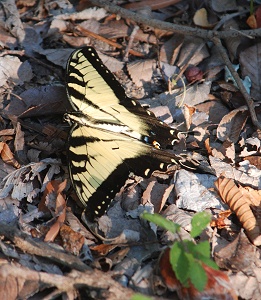 This individual landed on the trail, in a spot of early sun. As I tried to creep closer, it flew again but this time landed on a nearby bush, wings spread, with only one leaf partly obscuring a wing.
This individual landed on the trail, in a spot of early sun. As I tried to creep closer, it flew again but this time landed on a nearby bush, wings spread, with only one leaf partly obscuring a wing.
As this bush was in the shade, I used a flash. My first assumption was that this was an Eastern Tiger Swallowtail, Papilio glaucus, because the range maps show it here, with a gap to the west before the Western (P. rutulus) species starts up. But in the spirit of completeness, I carefully read the descriptions of both species. According to Glassberg’s Butterflies Through Binoculars: The West, one key ID point is the color of the topmost hindwing spot: orange in Eastern Tiger Swallowtails; yellow in Western. I checked with the older Peterson Field Guide book on butterflies: same point.
Only one top hindwing spot is visible in either photograph, and that one only partial…but it’s yellow.
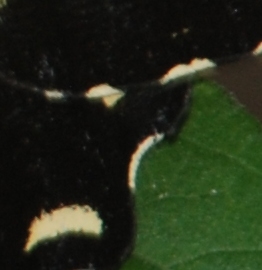 You can see it just peeking out from under the trailing edge of the forewing. That’s why I have a question in to the TX-Butterflies listserv: could I have an out-of-normal-range Western Tiger Swallowtail (perhaps some individuals moved east to escape mountain fires in Arizona or New Mexico or West Texas?) or do some Eastern Tiger Swallowtails have yellow HW spots? (When I get a definitive answer, I’ll update the blog…and, if it’s a new species for us, the species list.)
You can see it just peeking out from under the trailing edge of the forewing. That’s why I have a question in to the TX-Butterflies listserv: could I have an out-of-normal-range Western Tiger Swallowtail (perhaps some individuals moved east to escape mountain fires in Arizona or New Mexico or West Texas?) or do some Eastern Tiger Swallowtails have yellow HW spots? (When I get a definitive answer, I’ll update the blog…and, if it’s a new species for us, the species list.)
All this mystery before I even got to the new plant!! After that I walked on through the woods (two smaller, duller butterflies fluttered away into a tall stand of giant ragweed: I didn’t follow.) When I got to Westbrook, most of the plants (there were several) of the mystery flower were dying, the flowers dried to seedheads, but one had a few blooms still on it:
Sparse, small ray flowers, a domed head of disk flowers neither yellow-green nor dark brown/purple. Each ray flower’s petal has three tiny lobes and was touched with a bit of red at the center. Here’s what a spray of them looked like:
Given the drought and heat, with other Composites on the place showing smaller flowers (and particularly shortened ray flower petals) than usual, I don’t know if this is the normal size/shape of the this flower, or a response to drought. At the moment it’s not easy to figure out from the easier books I have, and I’m short of time for digging into the big fat Manual of the Vascular Plants of Texas. I’m thinking some species of Helenium, but I could sure be wrong. So an image will go off to someone more expert than I, and if it’s a species we don’t already have, it’ll go on the list of plant species.
After that, I walked on over to Owl Pavilion to check the water level, and spooked a deer on the way through Dragon Alley (a narrowish passage between the south fencerow and the creek woods where dragonflies are numerous–and they were, but they were all flying rapidly above head level, so no photographs. And the deer made it across the gap in two bounds before I could get the camera up.
On the way back from Owl, I was just at the entrance to Dragon Alley when I spotted glowing ears. The thin ears of rabbits and hares (jackrabbits) glow like lanterns in the low slanting light early in the morning or late in the evening, making them easy to spot when the animal itself is well camouflaged.
I ran out of the telephoto lens, and started taking shots while moving very slowly forward. Shooting up-sun with this camera is never as successful as I could wish but I like the glowing ears. The cottontail was grazing, mowing the Dragon Alley grass. Finally it hopped on across the grass and into the creek woods, and I went on by.
Although it’s extremely dry and hot, there’s still some green grass for grazers like the bunnies–and thus food for their predators, the coyote and fox and hawk. Most of the grasses in Dragon Alley are natives, tough and drought-resistant.
ADDENDUM: Two experts concur: the butterfly is the Eastern Tiger Swallowtail on multiple ID points. Just happens to have yellow HW spots. I do love how quickly you can get expert consultation on such things online!
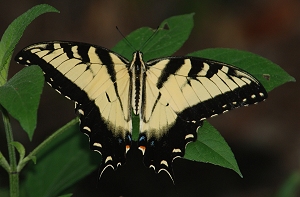
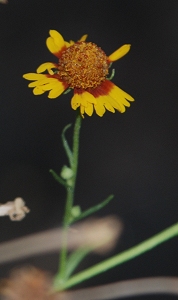
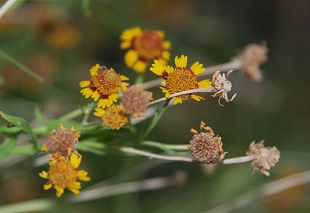
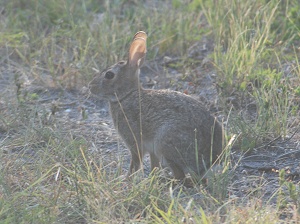
Comment by Robert — July 8, 2011 @ 2:08 pm
Nice shooting. Thanks for sharing.
It’s just too hot for me to get out except very early, and at that time the backyard is too deep in the shade to shoot anything moving.
Robert
Comment by Adrianne — July 9, 2011 @ 9:28 am
How very interesting. I shot my first tiger swallowtail this week too. I had no idea that there were Eastern and Western versions. Mine very definitely has yellow HW spots, and according to the Northern Prairie Wildlife Center, this county is firmly in Western Tiger swallowtail territory, but my home county gets both. Now I’ll be studying all the butterflies I’m lucky enough to catch with a camera.
I love the bunny ears! I rarely see them unless I catch the light through their ears.
I’ll be curious to learn what your flower turns out to be. I think I’ve seen the like in CO.
Let me know what you decide the flower is. I think we get those up in CO too.
Comment by elizabeth — July 9, 2011 @ 10:29 am
My expert helpers on the ID both said the Western is a mountain butterfly by preference, has narrower forewings than the Eastern (I couldn’t see that in the photographs in the books, myself.) The shape of the HW spots matters, and they could tell the one in my image–even half-hidden–wasn’t right. They said most Easterns have orange spots, but not all–and the spot color isn’t the only or best diagnostic point.